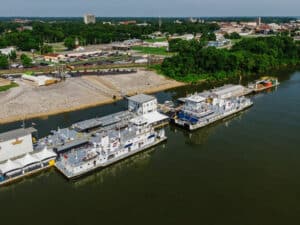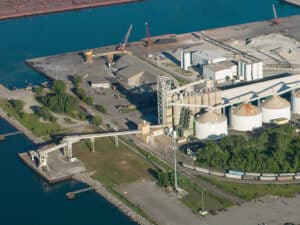
5 minutes with new EBDG president Robert Ekse
Written by Heather Ervin
Elliott Bay Design Group CEO Robert Ekse
In April, Elliott Bay Design Group (EBDG) announced the appointment of Robert Ekse to president and a principal of the naval architecture and marine engineering company. His background includes a 30-year career in the marine industry, working for both operators and shipyards along the West Coast.
To find out more about him and his maritime experience, we asked him a few questions:
Marine Log (ML): What is your maritime background and what brought you to EBDG?
Robert Ekse (RE): I started my maritime career in 1991 after graduating from Southern Maine College with a degree in marine science engineering. Shortly after school, I started sailing as a licensed engineer on steam and diesel ships out of the Gulf of Mexico and the West Coast. After the birth of our first child, I decided to return shoreside and took a port engineering position with Crowley Maritime in Valdez, Alaska. There, I had the opportunity to work with modern tug designs and state of the art technology after the Valdez oil spill.
In 2000, I started working with Alaska Ship and Drydock (ASD) in Ketchikan as a project manager of ship repair projects. While there, I worked on a variety of vessel repair projects for tugs, barges, fishing vessels, USCG buoy tenders and ferries. After Alaska Marine Highway System relocated from Juneau, Alaska, to Ketchikan, I took a job there as vessel construction manager managing federally funded ferry capital improvement projects then eventually became the program manager of that department.
I was then hired on with Vigor Marine in 2011 as a senior project manager of ship repair in their Portland, Ore., yard. During my tenure with Vigor, I held several positions within their ship repair business including general manager, ship repair of Puget Sound, out of Seattle, Wash. In 2018, I joined EBDG as a project manager. At that time, the company was being led by Brian King, who I had met in Ketchikan during my first project with ASD in 2000. His passion intrigued me and after just a short time at EBDG I understood the driving force of that passion: the staff, the clients, and the variety of projects.
ML: Can you tell us more about your time with companies like Vigor and Crowley? What were some milestones you were there to witness?
RE: I started working for Vigor during the acquisition of the Ketchikan Shipyard, Kvichak Marine, Oregon Iron Works, and just after the Mini yard acquisition in Tacoma. This was a time of significant expansion within Vigor. I witnessed growth, both in our capabilities as a yard and in our workforce. I met talented craftsman and skilled shipbuilders, many of which I am still connected to today.
While I was with Crowley, we expanded the fleet in Valdez from five conventional tugs and three staffed barges to seven tugs and five staffed barges after winning the entire Valdez Ship Escort and Assist contract from our competitor. The tug fleet consisted of two brand new state-of-the-art designs (Enhanced Tractor Tugs and Prevention and Rescue Response Tugs) with Voith and Aqua Master propulsion systems. Crowley was departing from their traditional service in Alaska and migrating to a Ship Escort and Assist model up and down the West Coast.
ML: Are there any big projects underway at EBDG that you can discuss with us? Even a few hints will be nice!
RE: One of the largest high-profile projects we have underway and nearing completion is the functional design for the new hybrid-electric Olympic Class ferries for Washington State Ferries (WSF) that will be built within the family of Vigor yards in the area. Once completed, this ferry is expected to be the largest new build battery-powered ferry in North America. This project will set a benchmark in terms of size and electric capacity in the United States.
On the opposite coast, we expect to see the first Ollis Class Staten Island Ferry enter service this year. Our team has worked diligently on this project for several years—it will be an exhilarating feeling to see their first of three 4,500-passenger ferries of our design enter operating service.
We are also engaging a far greater number of clients on alternative propulsion analysis as companies assess their entry point into repowering older vessels.
ML: Could you outline some challenges to modern-day naval architecture and how does EBDG meet those challenges?
RE: The tools we use to do our jobs each day are evolving. Naval architecture firms must watch this field very carefully and choose the right set of software to adopt. On one hand, we must be able to design in the 3D model space. On the other, we need to remain flexible enough for those clients that don’t want or need that level of design. EBDG is adopting software that can provide this 3D capability while still being able to provide standard 2D products.
Clients have a thirst for “seeing” a design or application of a design modification up front and outside of the typical model space. EBDG is using scanning technology along with rendering capabilities to convey this level of communication as early in the process as possible.
ML: Being more “green” is something EBDG has been on top of for years. Can you tell us more about your green design and how you see that continuing to develop as we move toward a more environmentally friendly climate?
RE: From trim optimization of existing vessels, efficient hull form design of new vessels, to partnering with key technology providers, we have an excellent integration team that can help owners achieve the levels of efficiency and emissions that suit their business model. Alternative energy power systems is a growing market. Between the prospect of battery or hybrid for shorter runs and hydrogen fuel cell for tougher routes, EBDG can help clients navigate through these critical decisions whether considering repowers of existing fleets or new construction.


![Tom Frazier aground and listing to starboard on Feb. 11, 2024. [Photo: U.S. Coast Guard]](https://www.marinelog.com/wp-content/uploads/2025/06/Towboataground-300x225.jpg)

